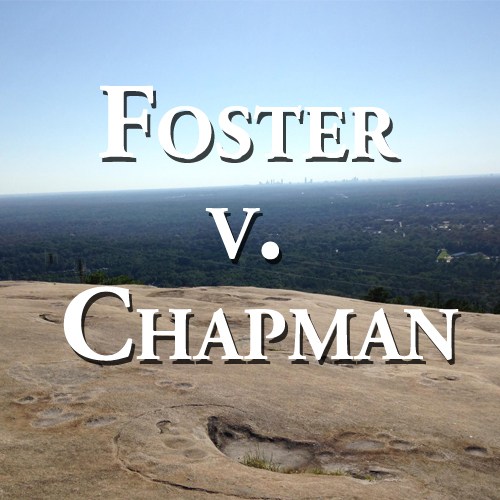Foster v Chapman: Excluding Jurors Based on Race

In Foster v Chatman (2016), the U.S. Supreme Court held that prosecutors purposely discriminated against a Georgia man facing the death penalty when they dismissed two black jurors during jury selection. The Court’s narrow decision was largely based on the egregious nature of the Batson violations and, therefore, may do little to deter the discriminatory use of race in jury selection.
The Facts of Foster v Chatman
Timothy Tyrone Foster, a black defendant, was charged with killing an elderly white woman. The prosecutor struck all four black prospective jurors. At trial and on direct appeal, Georgia’s courts denied Foster’s claim of race discrimination under Batson v. Kentucky, 476 U.S. 79 (1986).
During state habeas corpus proceedings, Foster obtained the prosecution’s notes from jury selection, which were previously withheld. The notes reveal that the prosecution (1) marked the names of the black prospective jurors with a “B” and highlighted them in green on four copies of the venire list; (2) circled the word “BLACK” next to the “Race” question on five juror questionnaires; (3) identified three black prospective jurors as “B#1,” “B#2,” and “B#3”; (4) ranked the black prospective jurors against each other in case “it comes down to having to pick one of the black jurors”; and (5) gave explanations for its strikes that were contradicted by its notes.
Nonetheless, the courts again declined to find a Batson violation. Because Foster’s renewed Batson claim “fail[ed] to demonstrate purposeful discrimination,” the court concluded that he had failed to show “any change in the facts sufficient to overcome” the state law doctrine of res judicata.
The Legal Background of Foster v Chatman
Preemptory challenges allow lawyers to exclude a potential juror without providing any reason or explanation. However, in Batson v. Kentucky, the U.S. Supreme Court held that the Equal Protection Clause of the U.S. Constitution prohibited the use of peremptory challenges to exclude prospective jurors based on their race and established a three-part test to determine whether discrimination has occurred. “First, a defendant must make a prima facie showing that a preemptory challenge has been exercised on the basis of race; second, if that showing has been made, the prosecution must offer a race-neutral basis for striking the juror in question; and third, in light of the parties’ submissions, the trial court must determine whether the defendant has shown purposeful discrimination.”
The Court’s Decision on Foster v Chatman
By a vote of 7-1, the Court held that “the decision of the Georgia Supreme Court that Foster failed to show purposeful discrimination was clearly erroneous.” Chief Justice John Roberts wrote the majority opinion.
According to the Court, Foster established purposeful racial discrimination in the prosecution’s dismissal of at least two black jurors. “Two peremptory strikes on the basis of race are two more than the Constitution allows,” the Chief Justice wrote.
As highlighted by Chief Justice Roberts, although prosecutors offered race-neutral justifications for both peremptory challenges, the newly-discovered evidence showed that all of the justifications were merely pretextual. “Evidence that a prosecutor’s reasons for striking a black prospective juror apply equally to an otherwise similar nonblack prospective juror who is allowed to serve tends to suggest purposeful discrimination,” the Chief Justice noted. “Such evidence is compelling with respect to Garrett and Hood and, along with the prosecution’s shifting explanations, misrepresentations of the record, and persistent focus on race, leads to the conclusion that the striking of those prospective jurors was ‘motivated in substantial part by discriminatory intent.’”
Given the new evidence, the majority held that Foster was entitled to have his Batson claim reheard.
Previous Articles
Key Takeaways from Oral Arguments in Court’s Controversial Voting-Rights Case
by DONALD SCARINCI on November 12, 2025
The U.S. Supreme Court recently heard oral arguments in Louisiana v. Callais, which involves a key ...
Key Cases to Watch During the Supreme Court’s November Sitting
by DONALD SCARINCI on November 5, 2025
The U.S. Supreme Court’s November sitting begins on November 3 and concludes on November 12, 2025...
SCOTUS Clears Way to Terminate Protected Status for Venezuelan Nationals
by DONALD SCARINCI on October 29, 2025
On October 3, 2025, the U.S. Supreme Court granted an emergency request from the Trump Administrati...
The Amendments
-
Amendment1
- Establishment ClauseFree Exercise Clause
- Freedom of Speech
- Freedoms of Press
- Freedom of Assembly, and Petitition
-
Amendment2
- The Right to Bear Arms
-
Amendment4
- Unreasonable Searches and Seizures
-
Amendment5
- Due Process
- Eminent Domain
- Rights of Criminal Defendants
Preamble to the Bill of Rights
Congress of the United States begun and held at the City of New-York, on Wednesday the fourth of March, one thousand seven hundred and eighty nine.
THE Conventions of a number of the States, having at the time of their adopting the Constitution, expressed a desire, in order to prevent misconstruction or abuse of its powers, that further declaratory and restrictive clauses should be added: And as extending the ground of public confidence in the Government, will best ensure the beneficent ends of its institution.





